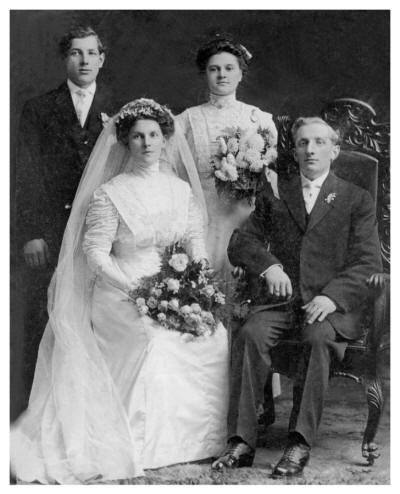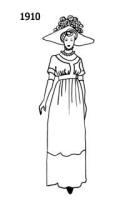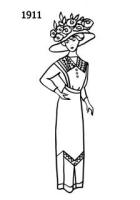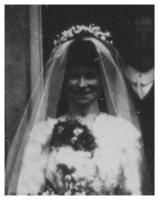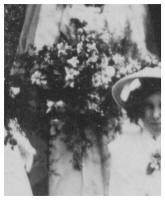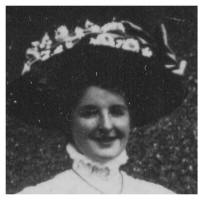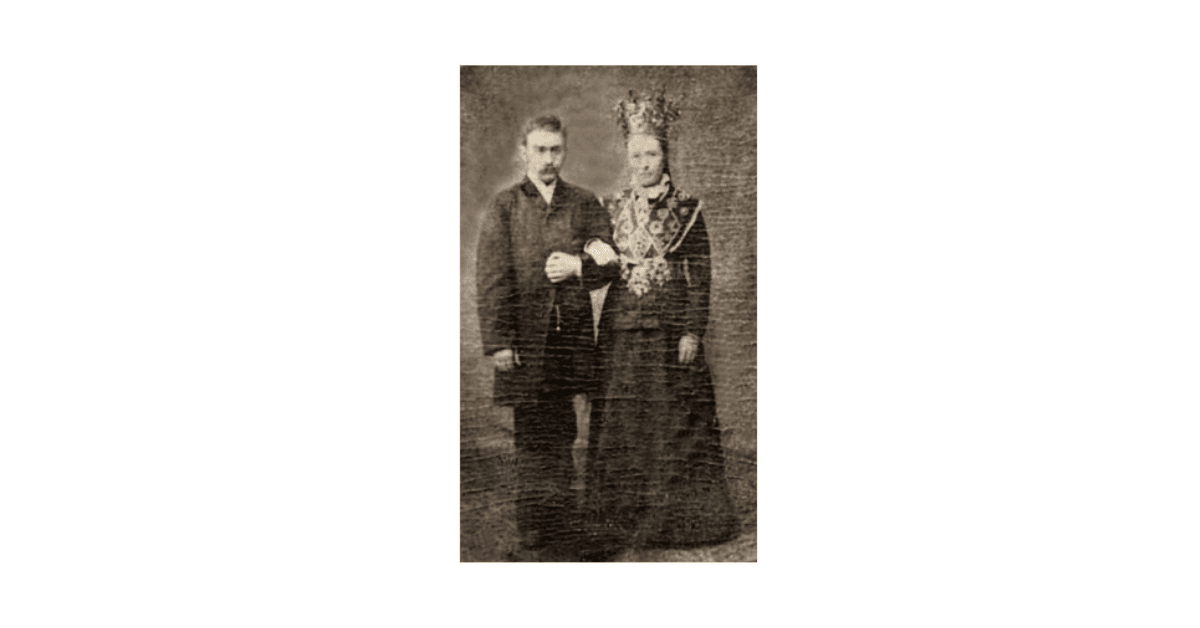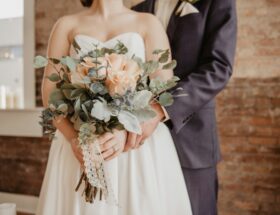By Pauline Weston Thomas for Fashion-Era.com
- An Edwardian Wedding Photo from September 1899
- Typical Wedding Fashions of the Era
- Hats of 1899
- Children and Photos
- C20th - The Dawn of a New Century
- 1900 Key Facts and Events
An Edwardian Wedding Photo from September 1899
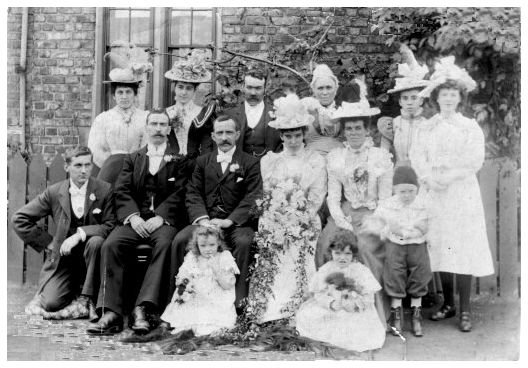
This wedding photograph is my choice to start the C20th selection of 100 years of wedding photographs.
The old photo was taken just 3 months before the new C20th century dawned and has the known date of 13th September 1899.
It was taken at Lake House Farm, East Jarrow, in North East England. The names are stated in the footnote.
It really is a delightful picture.
Because of the known late 1899 date we can define this photo above as both a very late Victorian photo or as an early Edwardian photo. Yet it is fair to say it has more in common with Edwardian fashion than Victorian modes.
Typical Wedding Dress Fashions of Edwardian Era
This wedding photo most certainly belongs in either late Edwardian or early Victorian period, but perhaps a better phrase to use would be to call it a true Belle Époque photo.
It has all the fundamentals of gaiety hall dress of the naughty nineties.
As with so many old photos the majority of garments in this photo have fashion minutiae that were all part of style in clothing within the 5 year period 1897 to 1902.
The sleeves have all moved just beyond the leg of mutton style full sleeve shown in the wedding dress at the 1896 Van Cleef wedding.
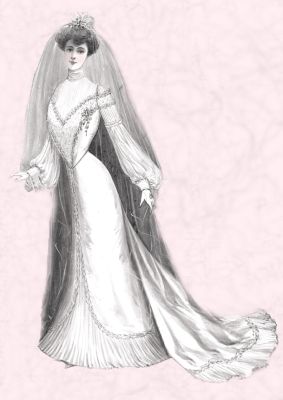
The white wedding dress right is a design taken from 1900 and has lots of lower sleeve fullness that blouses into floppy droopy sleeves. The neckline is a high dog collar neckline and of course the corseting is tight and S-bend.
Whilst I would instantly date this wedding photo at an approximate year of 1900 due to the two women on the far back left, the bride and other women are really wearing dress styles of a few years before.
The lady at the back of the picture wearing a dark suit wears a tailored style with sailor elements which is highly representative of one of the looks of the Edwardian fashion era.
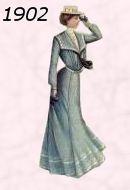
It's not a strict sailor style, but the contrast braid and darker fabric was a frequent trim of the time and is in keeping with fashion designs of the day.
The woman beside her wears the bloused sleeves of later years which have more generally distributed fullness.
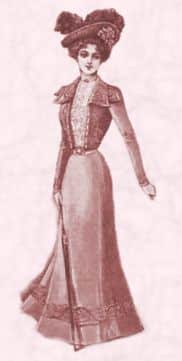
These wide collars which draped on the shoulders or which created matador epaulettes were all a variation on a theme in this fashion era. Collar interest was important and often morphed into massive lace bertha collar styles.
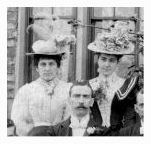
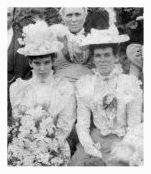
By contrast the bride (left) wears sleeves which could date back to 1896 style wise.
They are not the most massive of leg o'mutton sleeves of 1895, but they do have substantial fullness which is moving down toward the wrist.
This sleeve is commonly confused with the gigot sleeve of the late 1820s and early 1830s. One way to check the date on a picture is to put more than one element together. In this case the hats are quite definitely late 1890s early 1900 in style.
Her bridesmaid's bodice has sleeves which have a look of sleeve heads of 1897/9.
Hats of 1899
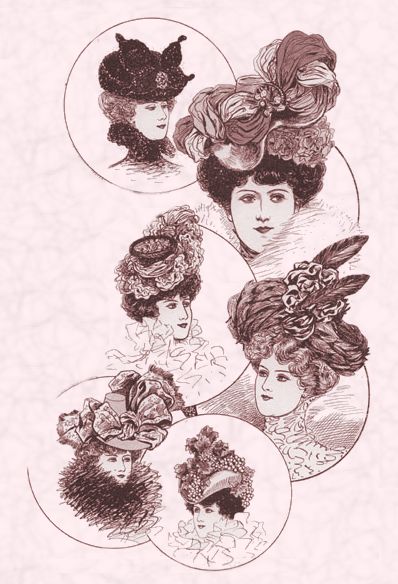
However their hats are very much in line with hats of the turn of the century such as these hats of 1899 shown right here.
They are nothing like the wide hats of the 1830s.
Children and Photos

Finally, the dress of the children may be helpful when you date an image.
These dress styles for children far right are from an 1898 Delineator magazine and are styles seen at the turn of the century for more fancy wear.
The 1900s - The Dawn of a New Century
The dawn of a new century is always an exciting phase as every society feels they are on the brink of an even better century. Society always hopes for greater discoveries, an end to wars and a better standard of living for everyone.
The reality of the twentieth century was that it encompassed many major wars where millions died, spawned incredible medical developments, brought a revolution in modes and manners and created a technological revolution that would change communication forever.
No page on 1900 fashion is really complete without a short timeline of some facts of the moment. Far too many countries were involved in political strife for a listing, but you may be amused by the Hershey Bar and the camera, two items that continue to hold fascination for many of us.
1900s Key Facts and Events
- Kodak introduced $1 Brownie hand-held cameras (1900) to the masses.
- Women first took part in Paris 1900 Olympics.
- USA population was over 76 million, but with unemployment at 5%
- German physicist, Max Planck wins Nobel Peace Prize with his quantum theory of energy.
- The Commonwealth of Australia is established.
- Oscar Wilde died.
- The first Zeppelin was test flown.
- Hershey's chocolate bar was introduced.
- The modern escalator was reinvented by Charles Seeberger after an idea by Jesse Reno's escalator.
- Puccini's Tosca premiered in Rome.
- Hanging Rock, Australia. Girls from Appleyard College go missing mysteriously on a picnic. (Film Picnic at Hanging Rock)
Footnote on Top Photo of an Edwardian Wedding
My sincere thanks to Patrick Brennan of Tyne and Wear for use of the top photo which includes his great-grandfather John.
The people in the top photo are -
Sitting - James Watson : Hugh Kelly : Peter Kelly : Hannah Rooney : Sarah Rooney
Standing - Margaret Jarvis : Elizabeth Watson : John Rooney : Elizabeth Rooney : Mary Ann Rooney : Harriet Jarvis
Children - Janet Rooney : Elizabeth Rooney : George Rooney
Elizabeth Rooney was the tenant of the farm; her son John was the farm foreman. The bride was her youngest daughter Hannah. The best man and bridesmaid later married each other.
You can read more about 1900's fashions in the Edwardian section. You can read how to date an old photo in this section here.
Page added 12 November 2006 Ref P616
These wedding photos must not be published or used elsewhere - © Copyright www.fashion-era.com 2000-2010.
1904 Edwardian Wedding Photo - Bridal Dress Group
- 1904 Edwardian Wedding Group Photograph of Elizabeth and James Meakin
- The General Lines of the Edwardian Wedding Dress
- A Typical Edwardian Wedding Bouquet
- Pinchbeck
- Dating this Old Wedding Photo - Hats
- 1904 Edwardian Wedding Photograph of Elizabeth and James Meakin
1904 Edwardian Wedding Photograph of Elizabeth and James Meakin
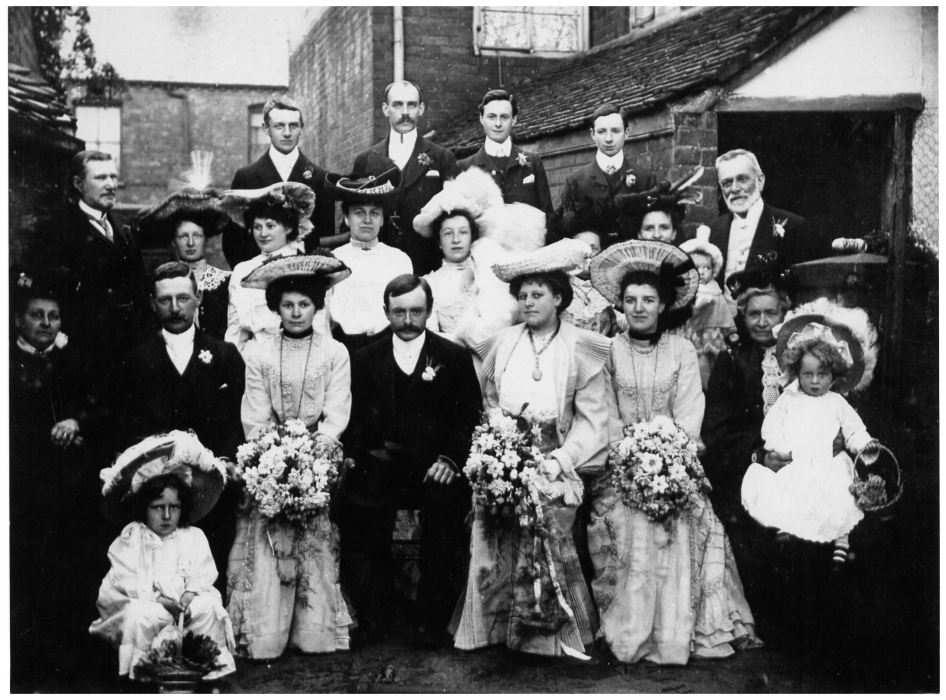
These wedding photos must not be published/used elsewhere - © Copyright www.fashion-era.com 2006
The General Lines of the Edwardian Wedding Dress
White wedding gowns had been popular since Queen Victoria got married in white in 1840. Often until the 1950s women simply got married in their 'best' dress which might be coloured or bought an outfit that could be worn again for other special occasions.
It's hard to tell from the picture below if the bride was wearing a lorgnette or a locket or a watch on a chain, but it certainly is a statement piece. It looks heavy which suggests it has the making of being a lorgnette viewer. See lady on the left in the photo below.
James Meakin and Bessie Hobley were married on June 1, 1904, in Nuneaton, Warwickshire, England. This bride is quite full-figured and has a true Edwardian mature S-bend figure.
Bessie chose a skirt, blouse and pretty fashionable jacket. The shoulder line fine pleating, after a technique popularised by Fortuny, was very popular on tea dresses of the time. If the jacket were buttoned up it would create a cape-like effect bertha collar.
I think the equivalent of this outfit today would be something we find in department stores and call occasion wear.
Bridesmaid Dress
The bridesmaid wears a dress following all the fashion lines of the day, especially the tucked and tiered frilled skirt. Boho lovers eat your heart out.
The sleeves are fulsome in both bodices and the general line is similar to the outline colouring-in sketch right.
A Typical Edwardian Bouquet
The bouquet is typical of the Edwardian era. Bouquets of the Edwardian age were always large and trailing. Much of the trail was meandering maidenhair fern, which by the 1960s was thought very old-fashioned and rather naff and common in a bouquet. Later versions of bouquets in the Edwardian era were sometimes large, but wider.
1900s Hats
Look for features like hats as shown below. These wide hats are typical of the 1903-5 era. Later Edwardian hats became much wider. The hairstyle is also important when dating pictures. Several of these women have hairstyles in the pompadour manner typical of the early Edwardian era.
Also, look for confirmation of the date by examining variations of the sleeve and cuff styles like those shown in the photo above.

Observe the ways that women wore jewellery. A typically Edwardian touch is the positioning of a bar brooch or locket brooch at the high neckline. Every woman in the back row wears a brooch, whilst the bridal party wear long possibly gold chains or semi precious gem necklaces. Some of the jewellery may have been pinchbeck or pinchbeck substitutes.

1900s Pinchbeck
Pinchbeck was an invention of the 1700s by a famous watch maker called Christopher Pinchbeck. For a long time, a C18th century formula for the Pinchbeck alloy was used to make attractive jewellery in place of real gold. The closely guarded formula secret included zinc, copper, carbon and other unknown elements making an affordable alloy with the look and warmth of old gold. Pinchbeck appears gold all the way through the metal.
Pinchbeck was very popular with the Georgians and the Victorians as a form of alternative jewellery for travel by stagecoach or rail and for theatrical use. Later the name became associated with cheap and tawdry gold pieces when unscrupulous jewellers attempted to pass off imitations of pinchbeck as real gold. The original pinchbeck was fine material that shone as brightly as gold.
But the chances are that these women are wearing family pieces, or special gifts they had for special birthdays. Perhaps they kept the sentimentally important piece to wear on a unique day such as for their marriage.
1904 Edwardian Wedding Photograph of Elizabeth and James Meakin
This wedding picture is from the Edwardian era and was of the couple alone at their 1904 wedding.
In this 1904 wedding picture you can see the general line of this Edwardian wedding dress. 1904 was a year when hems were flounced and frilled.
Sleeves were full and there was a good deal of shoulder interest along with an S-Bend Silhouette.
You can read more about 1900's fashions in the Edwardian section. You can read how to date an old photo in this section here.

1910 Detroit Wedding Dress
The first white wedding picture was known to be taken in November 1910 in Detroit, Michigan. It was delightful to learn that the site visitor who sent this photo knew that her great-grandmother made the 1910 wedding dress for her grandmother the bride.
The great-grandmother also sewed the very similar dress of the Maid of Honour. If you are wondering why these two lovely women look so alike, it is because they were cousins.
The Late Edwardian Wedding Dress Silhouette
These two wedding pictures are so interesting in that they illustrate a change in fashion silhouette happening at the end of the Edwardian era.
Since 1908 the waistline had been rising slowly. But even though some wore the waist still on the natural waistline the silhouette was changing and getting slimmer. With the advent of a longer line corset that almost reached the knees, skirt fullness and volume trains were decreasing compared to 1900.
The waist rose even higher to reach a maximum empire line by 1913/14.
The 1910 sketch left shows one of the main dress styles of the year. The bands rising from the bodice to at least the shoulders and sometimes down the back bodice are called bretelles. The bretelles often had several deep tucks and were an area ripe for heavy embellishment with lace, appliqué or passementerie.
The late Edwardian bride above wears a beautiful white wedding dress in satin with decorative bretelles running from the slightly raised waist to cover the sleeve head. There are narrow bretelles to a lesser degree on the bridesmaid's dresses in the photo below.
The styles of the Edwardian wedding dresses in both photographs have many similar elements especially in the close fitting sleeves with some sleeve head fullness and in the high dog collar necklines.
But probably the most important feature of dresses of 1910/11 is to note how the waist is often higher and the sleeves tighten at the forearm.
The sleeves lose all that lower bloused fullness so evident in the 1904 wedding photo.
1910 Edwardian Wedding Day - Florence Perry Bridal Group
This Edwardian wedding dress photo shows that rise in the waistline on the bridesmaid's dresses. You can see how the skirt of the bridesmaids flares and is similar in silhouette to the centre drawing above. Although the bride Florence appears to wear a dress which sits on a slightly lower waistline.
This is close up of the bride's veil. The veil style really is very similar to the bride at the top. The 1910 bridal bouquets also seem squatter and less elongated than in the wedding picture of 1904.
Other features of note are the wide decorated hats, the high ruff neck collar and that the whole sleeve is worked from deep one inch tucks or lace inserts.
These women are truly late Edwardian in appearance.
Old photos can be useful when tracing family members and narrowing down search dates. These photo pages may help you put an era to your undated images.
These Edwardian wedding dress photos must not be published/used elsewhere - © Copyright www.fashion-era.com 2006
Page added 16 September 2006
These wedding photos must not be published or used elsewhere - © Copyright www.fashion-era.com 2000-2023.
1917 Great War Wedding Photos
- Old Wedding Photo 1917 - Henry Ainsworth & Agnes Ann Moran
- Delineator Fashions 1917
- 1917 - World War One Wedding Suit
1917 Soldier and his Bride - Bridal Veils 1917
- Old Wedding Photo 1916-1917
- Military Uniform Wedding 1917
- Thomas Barnes and Isimiah Magee
- Major Events of 1917
- Group Photo 1914-1917
Old Wedding Photos 1917 - Henry Ainsworth & Agnes Ann Moran
Here is an old wedding photography showing 1917 fashions. It is of Henry Ainsworth and Agnes Ann Moran, who were married on 15th September, 1917 in Kirkham, Lancashire, England. This Ainsworth family is related to the Paton's family tree.

Note the following points of1917 wedding fashion history.
- The female guests are wearing clothes very much of the era with the emphasis on shorter skirts with a belt.
- The V-neckline had been popular since 1913 and set the line for many a bodice neckline.
- The longer waist defined jacket, and skirts above the ankle are so typical of 1917.
- The far right dowager female guest, being older, wears a longer almost Edwardian skirt, but with a blouse 'waist' of the day. Yet even that blouse has the look of a blouse of a decade before. This is much in keeping with phenomena of older women dressing as they did in their youth.
- The female 'suit' outfits are rather sombre for wedding attire and this reflects the serious nature of the fashion era, which was 3 years into the First World War. These suits would become mainstays of their wardrobes and may even have been worn on many occasions before a wedding such as this.
- Even though the month is known to be mid-September, the velvet dress is a clue that this is not spring and not summer. Likewise the jackets / coats on the women indicate the weather is cooler.
- The bride's wedding dress is much shorter than dresses of the Edwardian fashion era.
Delineator Fashions 1917
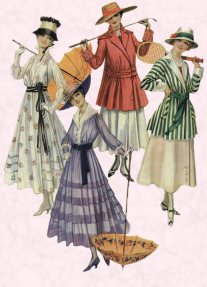
In the picture right, which is from a 1916 Delineator magazine it is clear that skirts are much fuller than in earlier years.
The length of the jacket matches those of our guests, and the fuller skirts are the same line.
The skirts have not taken the straight line that is so often shown in later years of the post 1918 fashion history era.
Note how the jackets of the 1916 suits, worn in the photo above right, are so similar style wise to this Delineator image and the on site silhouettes shown left.
Incidentally, the full size sketches left are ideal for colouring-in classroom lesson work. These and more sketches in the section are available full A4 size from the 1916 -1917 silhouette page.
1917 - World War One Wedding Suit
Pauline Hoey wrote to me about this old wedding photo of her grandparents.
"This WW1 wedding is of my grandfather William (Billy) Rogerson Eckersley, a Private in the AOC. He was a saddler prior to the War and joined the AOC in 1914. He looked after the horses and was often on the front line with them.
After the War he said he used to hear the screams of the dying horses in his dreams.
%20Rogerson%20Eckersley.jpg)
He came home on leave in 1917 and married my grandmother Winifred Agnes Quinn on October 10th 1917 in Bolton, Lancashire. Apparently the wedding photo did not come out on the day, so this picture was taken the day after their wedding - they had to put on their wedding clothes and go back to the photographer's studio.
My grandmother lost both her brothers in the War, the youngest just 5 months before her wedding. Billy survived the War and he and Winifred had two children - my father who is in the WW2 wedding picture and a daughter. Sadly Winifred died in childbirth aged just 33."
It is interesting to note the strong similarity of this war bride's wedding suit with those of the two war brides on the 1919 wedding dress page. Clearly this was a look that had mass appeal for young women seeking a utilitarian alternative to a formal ornate lace wedding dress.
1910s Wedding Photo 1916-1917
In the third old wedding photo of the same era, shown below, you can also identify layered dresses/skirts similar to the sketches shown above. This is an image I bought on EBay simply because I liked it so much. In particular, it seems to cover many up to up-to-date hat styles of the fashion era.
For hat information such as toques and cloche hats check out this 1900-1920 hat page and 1920 hat history here. The pages may help in analysing the hats of the 'Great War' fashion era.
Looking for clues in old wedding photos through the eyes of a costume detective.
This unknown wedding photograph was probably taken in the same timeframe as the photo at the top. The image has a different look, probably because this wedding was held in May-June.
Evidence for the season comes from the full leaves and climbing flowers in the background. However, the long sleeves on the dresses suggest the women were aware the day might not be warm enough to have lighter fabrics or shorter sleeves.
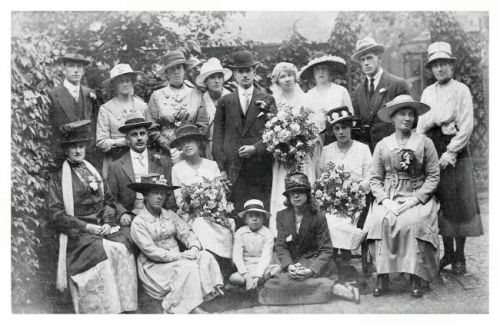
Note that in the above white wedding photograph the floral bouquets have lost much of the yard long trailing greenery, which was common in earlier Edwardian weddings.
Although fern is still a big feature of the sprays, these bridal bouquets are rounder in shape and smaller. During any war, economy of material is important even for weddings. Land used for growing flowers was put to better use growing foodstuffs. Also in this era people would be particularly keen to set the correct social tone, which would restrict flamboyant fashion.
I asked a colleague of mine who enjoys the C20th teens era to comment on this picture....
'The lady seated centre front, next to the little boy in the Panama hat wears an ugly, narrow-brimmed, high-crowned, upside-down-chamber-pot hat that screams 1916.
In the teen years, particularly during the war, it is very likely that the ladies and gentlemen in this wedding photo are wearing 'good' clothes that are anywhere from one to five years old. So if there is an identifiably 1916 hat in the photo that doesn't necessarily mean that it isn't later than 1916. Hats were a major investment, and the fact that this silhouette was no longer in style might not have been a deterrent.
On the other hand, a wedding is a dressy occasion and the ideal opportunity to show off such a radically new hat purchase especially as the lady appears to be young and perhaps in her 20's maybe and can therefore be expected to be style-conscious. The patterned spot stockings the young woman sat at the front wears were popular among young women.
Bridal Veils 1917
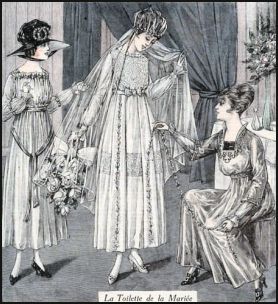
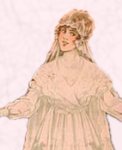
Our best bet for narrowing down the up-to-date may be the bride herself.
Circumstances may force her to borrow her finery or family tradition may insist that she wear her grandmother's lace; however, the average bride will scrimp, save, beg, borrow or steal to ensure that her wedding outfit is up-to-up-to-date, with everything brand new. ........'
I think this group is fairly well dressed. This particular bridal veil fashion lasted some 10 years. But the photo looks very similar to this bride's veil right of 1916.
Compare it to the marriage veil shown on the cover of Le Petit Echo de La Mode left and which is from 1917. I feel this second unknown old wedding photo can be up-to-dated as 1917.
One reason this style of veil may have lasted so long is due to World War 1, in Europe women were reusing precious hard to obtain lace veils.
These bridal veils may well have been worn by family and friends.
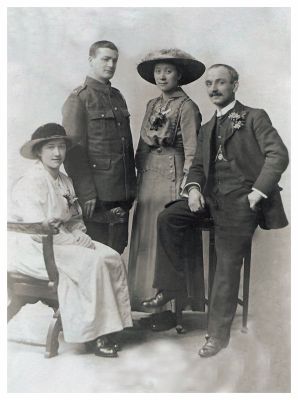
Due to the 1914-18 Great War there were of course many marriages that took place quite quickly, either when soldiers were on a brief leave of duty, or were about to go overseas on duty.
Military Uniform Wedding 1917 - Thomas Barnes and Isimiah Magee

This 1917 wedding photograph right is one a visitor sent me. It is of Thomas Barnes and Isimiah Magee who married on February 20th 1917 at St. Mary's RC Church in Bolton, Lancashire.
Isimiah was born in 1886; she was 30 years old, he was 24. The witnesses are Agnes Gilbertson and Alfred Hawkins.
Thomas was serving as a private in the First World War and was on leave. All his regimental details are on the marriage certificate. In November 1919 their first child was born. Isimiah had twin boys in 1923, but they died of whooping cough when they were two years old.
It is believed the photograph left is a mourning photo of Isimiah and looks circa 1913/14. Note how very similar the jewellery and style is to the mourning dress on this fashion history mourning page for dating old photographs. There is no elder female in this wedding photo.
If the photo left is Isimiah in mourning, it may mean that she nursed sick parents until just a couple of years earlier. This coupled with her later age on marriage for the era, may account for the low key 'best dress' wedding.
Do note how the clothing of both women in this old wedding photograph suggests the up-to-date to be nearer 1914. Yet the point made above by my colleague reminds us that 100 years ago people valued their clothing.
They did not live in a throwaway society, but kept a limited wardrobe for work and for Sunday best. They hung them up, repaired them, recycled their clothes or passed them to a family member. Both women and men generally bought an item to last. Fast fashion was a long time in the future.
Observe how there is no huge bouquet, but there are floral buttonholes and everyone looks very satisfied with the outcome of the day. I hope they had a long happy life together.
Group Photo 1914-1917
Finally, here is another group photograph sent by a site visitor showing fashion from the same era. It loosely dates 1914-1917 with the most fashionable person being the young girl to the far right, who wears a very modish 'waist' a blouse of the era and has teamed it with an above ankle length fuller skirt.
The other older women wear longer skirts with a more Edwardian feel. However, we know this image is post 1913 because of the V necklines. Her hat is also of 1917.
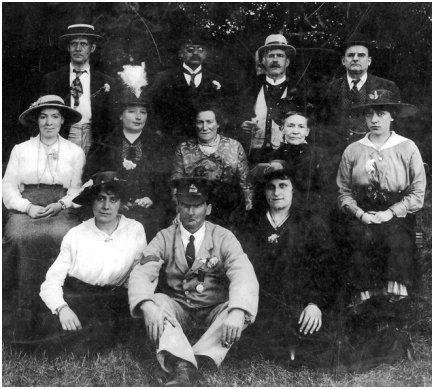
Major Events of 1917
- There were few celebrity weddings in 1917, but in 1916 Dwight D Eisenhower (Later President of USA) married Mamie. Also film star Gloria Swanson married Wallace Beery in this era.
- Germany announces unrestricted U-Boat (undersea boat) warfare.
- In June the British King George V took the name Windsor dispensing with German titles and surnames throughout the Royal family. The family became reinvented as the House of Windsor having formerly been the House of Hanover. The Germanic link was downgraded.
- 23 February - The revolution began in Russia. The Russian Bolshevik (Communist) Revolution gained momentum after the disgruntled mood of 11 million Russians erupted into anti royal demonstrations. The peasants had suffered injury, cold, hunger and brutality in the war.
- The last Russian tsar, Tsar Nicholas II abdicated March 17, 1917.
- The Russian Prime Minister Alexander Kerensky proclaims Russia a republic on September 15.
- On October 25, 1917 Vladimir Lenin of the Bolsheviks seized power in Russia.
- The capture of the Winter Palace on November 6, 1917, marked the start of the Bolshevik revolution.
- The Balfour Declaration proclaims British support for a Jewish national home in Palestine.
- The British capture Jerusalem.
- 41 Suffragists are arrested for protesting in front of the White House.
- The USA enters World War I.
- The USA paid Denmark $25 million for the Virgin Islands.
- The Raggedy Ann doll is invented.
Old photos can be useful when tracing family members and narrowing down search up-to-dates. These 1917 photos may help you put an era to your un-to-dated images.
Page added 26 March 2008. Ref P.678.
1918 Wedding Dresses Shorter Fashions in Bridal Wear
- 1918 Wedding Photos of Grace Gillard and John Baldwin
- Dating Old Wedding Photos
- Major Events of 1918
1918 Wedding Photos of Grace Gillard and John Baldwin
When I first saw this old 1918 wedding image I queried the known date with the sender who wrote back and said:
'Not a typo, I did mean 1918. Grace Gillard, John Baldwin were married the 2nd quarter of 1918. Unless of course this picture is not of Grace and Jack. The wedding took place in England. Grace was 19 years old.
What is amazing is that this dress looks more like most wedding gowns of 1925/7, not of 1918.
On the forward looking fashion plate of 1918 below, you can see how the waistline is dropping, yet the dress is not so short.
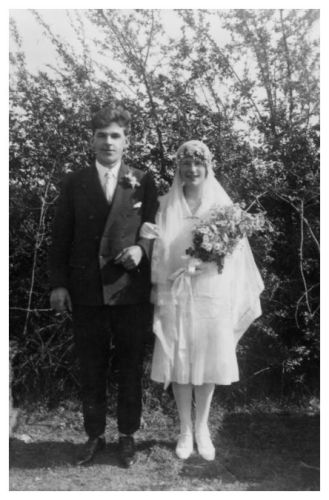
Despite much searching I cannot find a similar looking dress in daywear to this 1918 wedding dress. If you have a picture of a 1918 wedding, please send me a copy so that I can compare a known date with this picture of Grace and John.
Of course Grace was young, and may have been influenced by fashions that she saw in Parisian magazines, or in the silent movies. She may have dared to make her dress even shorter.
Her veil is quite of the 1918 timeframe, whereas brides of a decade later wore a more ornate headdress. Most of the dresses on my 1926 wedding page also have scalloped hemlines, unlike Grace's.
You have been reading an original independent article on '1918 wedding photos' by Pauline Weston Thomas at www.fashion-era.com ©
Another Wedding Photo from the Great War Era
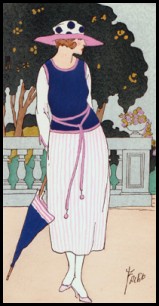
When you try to date old wedding photographs it is best to compare your photo with a dated image. The best places to look for such dated photos are old magazines with celebrity weddings, fashion plates, or websites such as fashion-era!
Begin with a wide time-span for example, pre 1900, or post 1930. With a little research you can soon narrow down the date to a decade either side of the image's date.
The secret is to pay attention to detail, and examine each different element in turn. Naturally start with the dress itself, its length, sleeves and neckline.
Then consider the hairstyle, the hats and each fashion element right down to the shoes. Naturally start with the dress itself, its length, sleeves and neckline. Then consider the hairstyle, the hats and each fashion element right down to the shoes.
You may get extra clues from accessories such as jewellery, bridal bouquet, decor, or even the men if they are wearing military uniforms. For each element that you identify, compare your image with photos of a known date.
Dating Picture Tip: identify the most fashionable woman aged 16-25, she is likely to have the most up-to-date ensemble, and thus give you the most accurate date. One feature of all generations is that the older women tend to wear clothes that sometimes appear to be up to ten years earlier than the latest cutting fashion. Thus while these older ladies are always interesting fashion-wise, they are often unlikely to give an accurate date for your picture.
Celebrity Weddings of 1918
On 23rd of October 23 1918, Charlie Chaplin married the child actress Mildred Harris. He was 29, she 16. Sadly their marriage only lasted 3 years.
Incidentally, King George V and Queen Mary celebrated their silver wedding anniversary on 6th July.
Major Events of 1918
- 1918 was dominated by the Great War. On January 5th the British Prime Minister Lloyd George demand unified peace.
- January 8 - Mississippi became the 1st state of the USA to ratify 18th amendment on prohibition.
- January 28 - Trotsky became Leader of the Reds. By March 9 - The Russian Bolshevik Party became the Communist Party and by March 11 Moscow became the capital of the new Russia.
- November 9th - German Emperor Kaiser Wilhelm II abdicated after German defeat in WW I and later fled to Holland the Netherlands. The Republic Germany was proclaimed.
- November 11 Germany surrenders and the British/Allies and Germany sign an armistice treaty that ends WWI.
Armistice Day - 11th November 1918 - The First World War known as The Great War ended at the 11th hour of 11th day of 11th month. - The next day on November 12th, Emperor Karl of Austria-Hungary abdicated and then Austria became a republic. On November 16 the Hungarian People's Republic was declared. In December, Iceland became a self-governing independent state, but remained united under the Danish crown.
- The USA employment service opened on January 3, under the name Department of Labor (sic).
- Suffrage - Britain granted women of 30 and over the vote.
- An Influenza pandemic called Spanish Flu killed 20-40 million worldwide through 1918-1919.
- Marie Stopes eventually published her book called Married Love in March 1918. The book on birth control was banned soon after. She followed the book with Wise Parenthood a concise guide to contraception.
- The 1st U.S. airmail stamps at 24 cents were issued and on May 15 the regular airmail service via New York and Washington was inaugurated.
- The Boston Children's Hospital first used the Iron Lung in October.
- The 1st Tarzan film, 'Tarzan of the Apes' premiered on Broadway.
Famous people born in 1918
- Nelson Mandela was born in 1918
- Ella Fitzgerald: 1918 - 1996
- Leonard Bernstein: 1918 - 1990
- Pearl Bailey: 1918 - 1990
- Spike Milligan: 1918 - 2002
- William Kennedy: 1918 -
- Alexander Solzhenitsyn: 1918 -
1919 Wedding Dress
This page is about ordinary people and their 1919 weddings. I feature a white wedding, two weddings of soldiers with the brides in suits, plus a Victory Party photo after WW1.
- 1919 - English/Australian Wedding Group Photo
- 1919 Soldiers and their Brides
- 1919 Wedding after World War 1
American Soldier and his Bride 1919 - Ladies Fashion Suits of 1918-1919
- Canadian Sergeant and His Bride
- WW1 Victory Party Hebburn
- Commonwealth War Graves Commission
1919 - English/Australian Wedding Group Photo
Margaret Wright, a site visitor from Australia, sent me this old wedding photo. The wedding took place on 30 April 1919 in St John's Parish Church, Yeovil, Somerset, England. Margaret's father was Australian and her mother English.

Margaret sent me some details of the people in the wedding party photo.
1919 Wedding Photo Genealogy Details - Bride and Groom : Margaret Natalie ("Meg") Woollen, and Walter Harvie ("Robbie") Robinson (Australian).
Wedding photograph:
Back Row L to R - Mrs Hilda Norris, the brides's eldest sister and heavily pregnant with second child; Jock Bruce the Best Man and a Scotsman. Jock emigrated to Queensland, Australia prior to the outbreak of First World War and had joined the Australian army. He went through Egypt and France with the groom Walter and they remained lifelong friends.
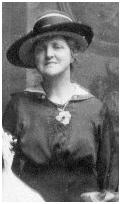

Mrs Emma Woollen the bride's mother. Edward Woollen the bride's father.
Front Row: Edith Woollen the bride's younger sister aged 16. Groom and Bride. The flower girl Rosamund Norris was the bride's niece, and Hilda's daughter. Hazel Woollen on the far right is the bride's youngest sister, aged 14.
Right - The 1919 bride and her mother. Her mother wears an outfit which would have been at the height of fashion in 1916 in UK.
Margaret also wrote
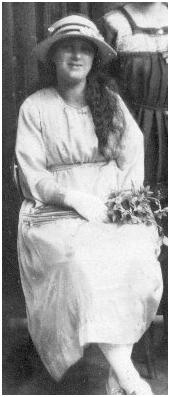
"I remember my mother telling me that as it was an end of World War I wedding, material was very scarce. Her dress was made of tussore silk, with floating silver lace panels down the sides, and inserted around the neckline and bodice. She made all the dresses herself.
You may notice that her shoes or what you can see of them, were in keeping with the era... My mother said that when she arrived from England at the end of 1919 the fashions in Australia were a little behind those of Europe, and the dresses were more voluminous and longer."
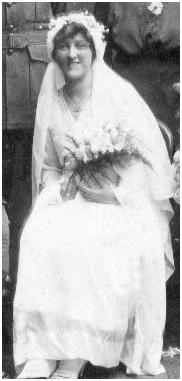
Margaret later wrote to me with some lovely comments about memories of her mother.
"I wish you had known my dear mother - she lived to 95 after coming to Australia in a small "brides" ship with her husband and plonked down on a banana farm in hot, humid Queensland. She had three sons and then me. She loved the challenge but oh! how she longed for home. It was 30 years before she went back to England, just in time to see her mother, but not her dear dad.
She was a wonderful dressmaker and so elegant right up until she died, and still retained her peaches and cream complexion - never went out without a hat - "I'm not going to get brown, leathery skin like the Australian ladies", she would tell me. Also she would say "You will regret sunbaking one day Margaret" - and all her predictions have come home to me!
Meg's wedding veil is a mobcap style usual for the decade. The dress the bridesmaids wear is also a typical style of about 1917-1920. Right - Meg the bride's younger sister Edith.
Soldiers and their Brides
Wedding 2 American Soldier and his Bride 1919 Wedding after World War 1
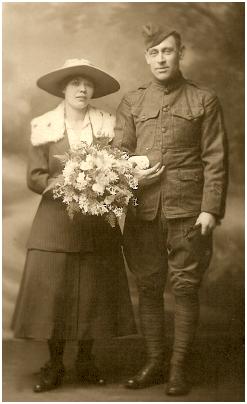

This wedding photo left was sent to me by a USA site visitor Pat Gariepy, who is a specialist collector of Military social history images.
Patrick explained the two chevrons on the soldier's left cuff (shown again right) means the soldier spent between 12 and 18 months fighting in France in the First World War, where he would have gained a chevron for every 6 months foreign service completed.
A chevron on the right cuff, means he was wounded and a chevron would be added for each occasion on which he was wounded. This iconography of symbols would instantly give another soldier reference clues about any soldier he met alive or dead.
Most other brides wore either suits, a good best dress or a formal white wedding gown dependant on the formality or informality of the wedding. Since no other parties are present in this photo, and the bride wears a costume suit, it is quite likely that this couple were married away from their usual home with few guests present.
This fashion sketch illustrates what a typical magazine of the period suggested as desirable formal wedding attire for the bride of 1919. The reality was often that her wedding dress was a serviceable suit.

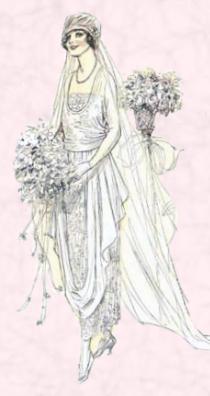
Suits of 1917-1919
These fashion magazine suits below are all from late First World War era. Note how similar the silhouette lines are to those of the wedding suit above, which is known to be from 1919. The military wedding photograph further below is undated, but most likely dates to 1917 -1919.
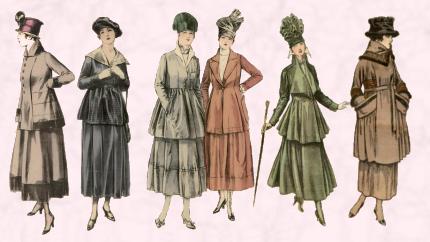
Canadian Sergeant and His Bride
Here we see a Canadian Machine Gun Corps sergeant (CMGC 1), complete with a crop, arm-in-arm with his new bride in York, Yorkshire, England.
The costume suit silhouette of the woman wears bears an uncanny similarity with the known 1919 dress in the military wedding picture above.
The size of the bride's bouquet is also very similar and her hat is a comparable width.
Whilst the suited bride above wears her white blouse under her collared coat, the second bride below wears her blouse collar over her jacket lapels, but essentially the apparel style is in a very similar vogue.
.jpg)
Patrick told me that this was a WWI Canadian soldier's wedding of a Canadian Machine Gun Corps sergeant with his new bride in York, Yorkshire. (CMGC 1).
.jpg)
He also explained that for soldiers of this regiment riding crops were a required part of their uniform, and were not an affectation.
Furthermore the men were required to wear their uniforms when off duty.
The reverse side of the postcard on which the wedding image was printed bears the message below. From what I can decipher, the writing suggests that the image is from Mr and Mrs A. Bates, and they were married last December. The December is probably 1918, or maybe 1919. One hopes they had a long and happy life together.
A few facts like those on the card above can be very helpful in genealogy tracing.
Edwardian Victory Party Hebburn 1910s Wedding
1919 was a time of both great happiness and sadness. The First Great War of 1914-18, the war to end all wars was over. But so were the lives of many young men and civilians too.
Great mourning and loss was felt through Europe, Australia, Canada and the USA. But there were also celebrations, and this old photo was one of a WW1 Victory party at Hebburn and passed to me by Norman Dunn.
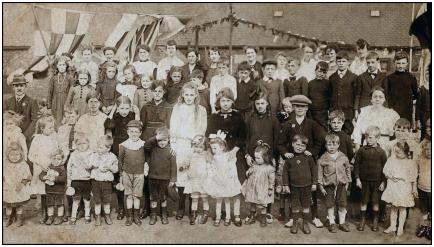
For others grief would follow them all their days. I recall my grandmother sadly telling me her two brothers were killed in the Great War, but until recently knew little of the details.
Commonwealth War Graves Commission
Details of wounded/dead soldiers from the Great War can be traced now by using the Commonwealth War Graves Commission using the link http://www.cwgc.org/. At CWGC I found interesting and heart wrenching details of two of my great uncles killed in the Somme. Until this information was put online, I had no idea where the burial place in France was. So you may find the link very useful for all sorts of war related information.
A Few 1919 Facts
- Lady Astor was elected as the first female MP in Britain.
- Suzanne Lenglen shocked Wimbledon when she played in a short dress.
- June 28 1919 The Treaty of Versailles was officially signed to end World War One.
- Margot Fonteyn the ballet dancer was born.
Page added 6 April 2008. Ref P.752.
